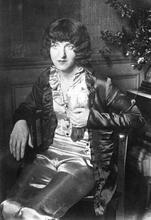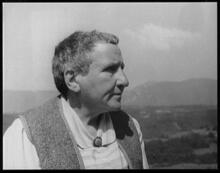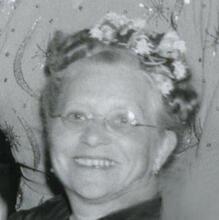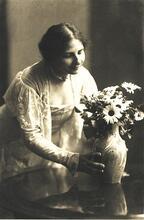Rose Shoshana
Born in Lodz, Poland, Rose Shoshana began her acting career in the Yiddish theater world, playing Manke in Got fun Nekome [God of Vengeance] in 1908. She went on to perform in Yiddish theater across Europe, then in Japan and China during World War II, and finally in New York after the war. In addition to her acting, Shoshana began a prolific career as a writer, translator, and journalist for the Forverts, where she edited a daily column about Jewish women.
On the Stage
The journey from Lodz, Poland, where Rose Shoshana was born on June 25, 1895, to New York was not an unusual one for an Eastern European Jewish woman of her time. This was, however, only one of many journeys Rose Shoshana made in her long career as a Yiddish actor, theater director, dramatist, writer, and translator. Born Esther Ruda Yakubovitch, she lost her father, a doctor, at age eight and was raised in poverty by her mother. At age twelve, she had to sew to earn money, but continued her studies in the evening at the Folk University at Geyer’s Market in Lodz.
As a child she began reciting poetry and acting in plays in school. In 1908, she made her dramatic debut with the Harfe troupe at the Groyses Teater as Manke in Sholem Asch’s Got fun Nekome [God of Vengeance]. In 1912, she married Lazar Kahan, a Yiddish writer, theater person, and Bundist political activist, who would be her partner in many theatrical and literary ventures. They had a daughter, Lila Kalianis, a singer. Throughout her long career, Shoshana performed with many theater troupes both in Europe and America.
A tour of Poland, begun in 1939, was interrupted by World War II. She and her husband fled to Vilna and then to Kovno in Lithuania. In 1941, they made their way through Siberia to Kobe, Japan, where Shoshana performed on the very night of her arrival. At the end of 1941, the couple went with the Bundist refugee group to Shanghai. There, they lived in the ghetto from 1942 to 1945, continuing their theatrical work. In 1946, her husband died of typhus in Shanghai. Their two sons, who remained behind in Europe, disappeared in Soviet territory. It was this experience of Warsaw under siege and, later, her life in the Shanghai ghetto that Shoshana described in her memoir, In Fayer un in Flamen [In fire and in flames]. This was her only work to appear in book form, published in 1949 in Buenos Aires under the name R. Shoshana-Kahan as part of the series Dos Poylishe Yidntum [Polish Jewry].
Author, Actor, Journalist
At the end of 1946, after recovering from typhus, Shoshana was brought to America, where she immediately became active as both an actor and journalist. She performed in the National Theater in 1946, in Dos Naye Pleytim Teater [New refugee theater], which she helped to create, and in Maurice Schwartz’s Art Theater in 1955. In 1957, she directed the Ensemble Theater.
Her career as a writer was no less prolific. She made her literary debut, according to Zilbercweig, in 1915, with a translation in Lodzer Tageblat of Morbeau’s “Death of a Dog.” From 1924 to 1930 she published novels and contributed to the women’s pages of Yiddish newspapers in Poland as well as to the Polish Pionta Rana.
In America, she continued her literary activity and was among the first to write about Nazi terror in the Yiddish press. In 1940 she published “Bletlekh fun a Togbukh” [Pages from a diary] in the Forverts under her own name. In 1941, the Kharbin Russian newspaper Yevreyski Zhizn [Jewish life] published her war notes, In Fayer un in Flamen, which later appeared as the Yiddish book mentioned above. In 1946, she published a series of articles about life in China in the Forverts and in the Amerikaner. Between February 1947 and October 1968, she published twelve novels in the Forverts. She also edited a daily column for the paper, “Di Froy un di Heym” [The woman and the home], under the name of Rose Mary. Although many of her novels were reprinted in newspapers in Lithuania, Argentina, and elsewhere, none of them was ever published in book form.
Shoshana’s work as a translator and dramatist includes translations of Karl Shener’s drama Tayvl’s Vayb [Devil’s wife], Der Friling [Springtime] by Heinreich Tsimerman, Yener [The other] by Gabriela Zapolska, Di Froy Vos Hot Derharget [The wife who killed] by Herricks, and Di Reter fun Moral [The saviors of morality] by Propan, in collaboration with her husband. She translated and dramatized Zind un Shtrof [Sin and punishment] by Zola and Farberovich’s Urke Nakhalnik, and dramatized her own novels Bashke and Ven dos Harts Iz Yung [When the heart is young], Zeyer Tsveyter Friling [Their second springtime], and Dos Geyeg Nokh Glik [The hunt for happiness].
Her film appearances include Lamed Vov [The thirty-six just men] and Joseph Opatoshu’s In Poylishe Velder [In Polish woods], both in 1926.
Rose Shoshana died on November 2, 1968.
Selected Works
Bletlekh fun a Togbukh [Pages from a diary] (1940).
Dos Geyeg Nokh Glik [The hunt for happiness] (1948).
Far Zeyere Zind [For their sins] (1957).
In Fayer un in Flamen [In fire and in flames] (1941. In book form, 1949).
Ir Mames Sod [Her mother’s secret] (1954).
Kinder on Tates [Children without fathers] (1951).
Libe un Has [Love and hate] (1955).
Nakhes fun Kinder [Joy from children] (1956).
Panna do Zhietchi [The children’s governess] (n.d.).
Plonter fun Lebn [The tangle of life] (1953).
Ven a Harts Iz Yung [When a heart is young] (1947).
Ven a Mame Muz Shvaygn [When a mother must be silent] (1949).
Ver Iz di Mame? [Who is the mother] (1953).
Yung Blut [Young blood] (1958).
Zeyer Tsveyter Friling [Their second springtime] (1950).
AJYB 70:525.
Botoshanski, Y. “Tsvishn yo un neyn” [Between yes and no]. Di Prese (Buenos Aires), April 25, 1949/50.
Niger, Shmuel. "Kahan, Shoshana." Leksikon fun der Nayer Yidisher Literatur [Lexicon of new Yiddish literature]. New York: 1959.
Obituaries. Forverts (New York), November 4, 1968, and New York Times, November 3, 1968, 89:1.
Rogoff, Hillel. “In Fayer un in Flamen—Togbukh fun di Milkhome Yorn.” Forverts (New York), May 7, 1950.
Zilbercweig, Zalmen, ed. Leksikon fun Yidishn Teater [Lexicon of Yiddish theater]. Vol. 3. New York: Elisheva, 1931.










